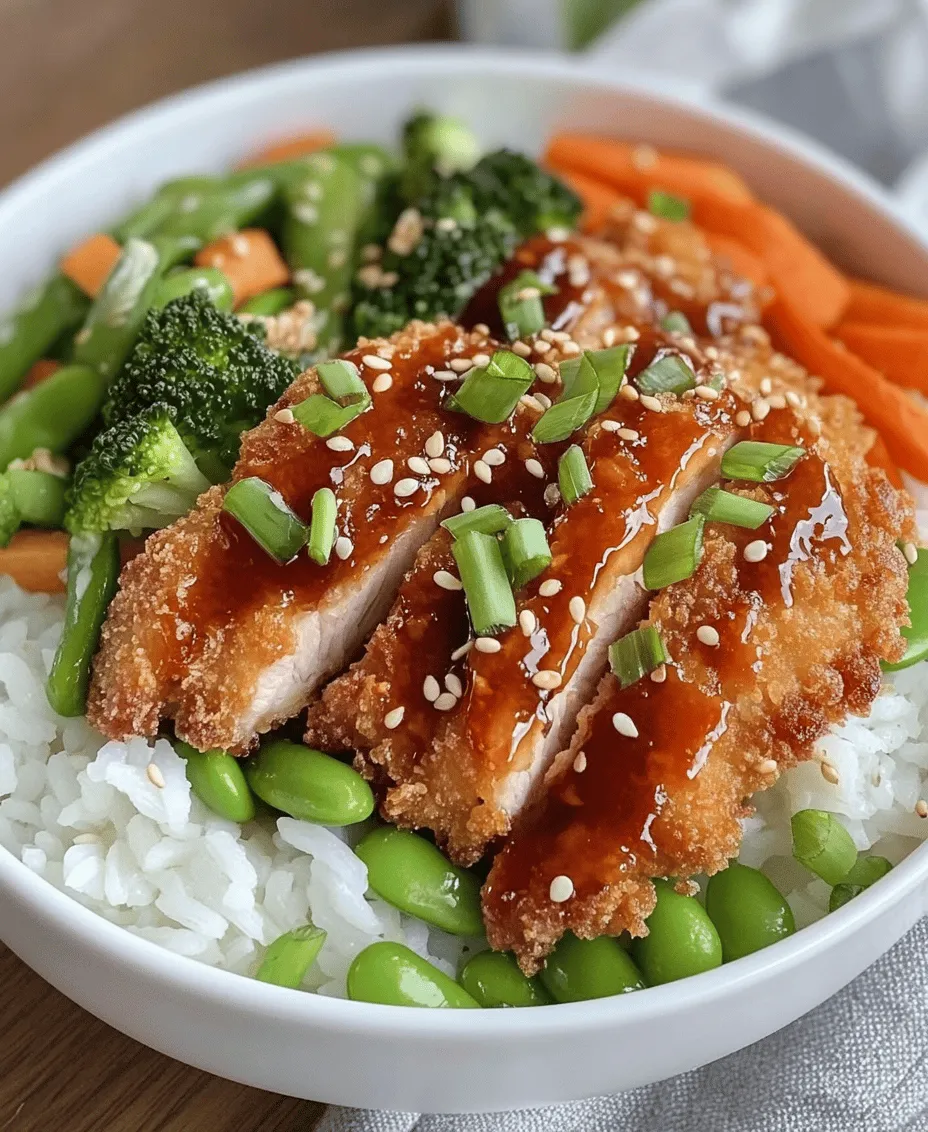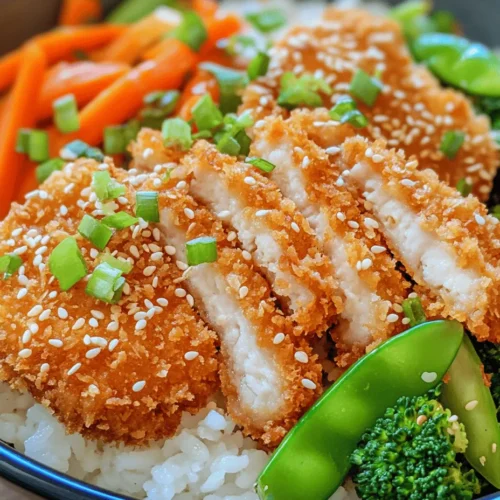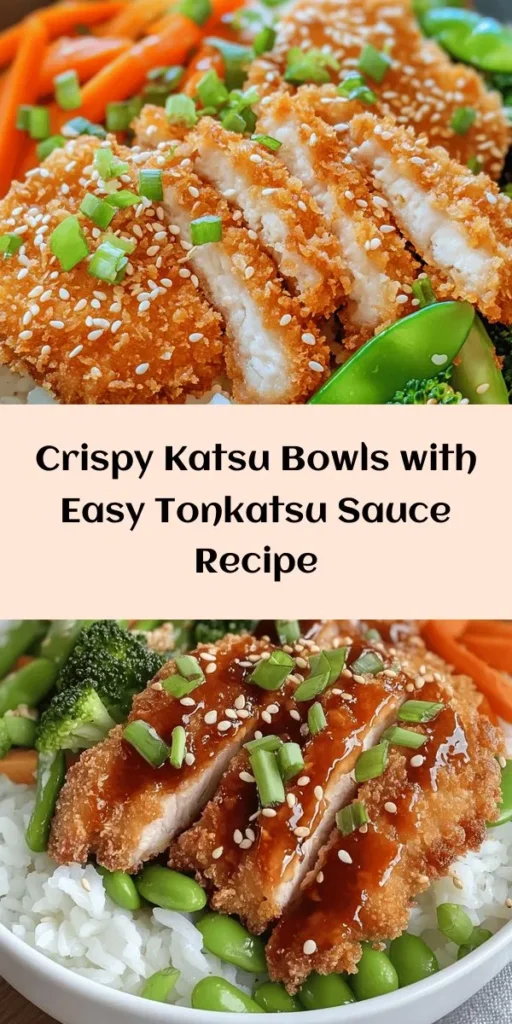Introduction to Crispy Katsu Bowls with Homemade Tonkatsu Sauce
Crispy Katsu Bowls are a delightful fusion of flavors and textures that effortlessly transport you to the bustling streets of Japan. This dish features golden-brown pork cutlets, known as katsu, paired with a rich homemade tonkatsu sauce, served over a bed of fluffy rice and vibrant vegetables. Katsu, which translates to “cutlet” in Japanese, is a beloved staple in Japanese cuisine, cherished for its satisfying crunch and savory taste.
The origins of katsu can be traced back to the late 19th century when Western-style breaded and fried cutlets were introduced to Japan. Over time, this dish evolved into a distinctly Japanese culinary treasure, with the introduction of the tonkatsu sauce, a sweet and tangy condiment that elevates the flavors of the crispy pork. Perfect for a weeknight dinner or a special occasion, this recipe showcases the ease of creating restaurant-quality meals at home.
In this article, we will delve into the ingredients, preparation steps, and the cultural significance of katsu, ensuring you have everything you need to make this delicious dish. Whether you are a seasoned cook or a novice in the kitchen, our step-by-step guide will help you navigate through the process of crafting the perfect crispy katsu bowl.
Understanding Katsu: A Japanese Culinary Staple
The Origins of Katsu
Katsu has a rich history that reflects Japan’s culinary evolution and cultural exchanges. The dish is believed to have been inspired by European cooking techniques, particularly the popularity of breaded and fried meats in Western countries. As Japan opened up to the West during the Meiji era (1868-1912), many Western foods made their way into Japanese kitchens. The adoption of the breading technique led to the creation of “tonkatsu,” a term that combines “ton,” meaning pork, and “katsu,” meaning cutlet.
Initially, tonkatsu was primarily enjoyed by the upper class, but its popularity quickly spread across social classes, making it a common dish in homes and restaurants throughout Japan. Today, katsu is not only a comfort food but also a symbol of the harmonious blend of Japanese and Western culinary traditions.
The Significance of Tonkatsu Sauce
Tonkatsu sauce is an essential component of the katsu experience. This thick, dark sauce is a sweet and tangy condiment made from a blend of ingredients, including Worcestershire sauce, soy sauce, ketchup, and various spices. Its unique flavor profile enhances the savory notes of the crispy pork and adds a layer of complexity to the dish.
The sauce is not just a mere accompaniment; it plays a crucial role in balancing the richness of the fried katsu. The sweetness cuts through the fat, while the acidity brightens the overall flavor, creating a harmonious blend that elevates the dish to new heights. Many chefs and home cooks take pride in creating their own versions of tonkatsu sauce, adjusting the ingredients to suit their personal preferences and taste sensations.
Ingredients Breakdown for the Perfect Katsu Bowl
Ingredients for Tonkatsu Sauce
Creating a homemade tonkatsu sauce is simple and rewarding. The following ingredients are essential for achieving a smooth and balanced sauce:
1. Worcestershire Sauce: This adds a depth of flavor and a slight tanginess to the sauce.
2. Soy Sauce: Provides umami and saltiness, enhancing the overall taste.
3. Ketchup: Adds sweetness and a rich tomato flavor, balancing the acidity.
4. Mirin or Rice Vinegar: Introduces a subtle sweetness and acidity, helping to round out the flavors.
5. Sugar: Enhances sweetness and thickens the sauce.
6. Garlic Powder: A hint of garlic adds complexity to the flavor.
7. Ground Ginger: Provides warmth and a touch of spiciness.
Ingredients for the Katsu
For the katsu itself, using high-quality, fresh pork chops is paramount. Here’s what you’ll need:
1. Pork Chops: Opt for boneless pork loin or tenderloin chops, which are lean yet flavorful.
2. Salt and Pepper: Basic seasonings that enhance the natural flavor of the meat.
3. All-Purpose Flour: Used for dredging the pork, creating a sticky surface for the breadcrumbs.
4. Eggs: Helps the breadcrumbs adhere to the meat and adds richness.
5. Panko Breadcrumbs: The star of the show! These Japanese-style breadcrumbs create a light and crispy coating.
Bowl Assembly Ingredients
To complete the katsu bowl, consider the following ingredients for assembly:
1. Rice: Short-grain Japanese rice is preferred for its sticky texture. You can opt for white or brown rice based on your preference.
2. Vegetables: Fresh vegetables add color and nutrition. Common options include shredded cabbage, julienned carrots, and sliced cucumbers.
3. Garnishes: Chopped green onions and sesame seeds provide a nice finish, adding texture and flavor to the dish.
Step-by-Step Guide to Making Crispy Katsu
Preparation of Tonkatsu Sauce
Start by making the tonkatsu sauce, as it can be prepared in advance and stored. Here’s how to create a smooth and balanced sauce:
1. Combine Ingredients: In a small mixing bowl, whisk together 3 tablespoons of Worcestershire sauce, 2 tablespoons of soy sauce, 2 tablespoons of ketchup, 1 tablespoon of mirin or rice vinegar, 1 tablespoon of sugar, ½ teaspoon of garlic powder, and ½ teaspoon of ground ginger.
2. Adjust to Taste: Taste the sauce and adjust the flavors as desired. If you prefer it sweeter, add more sugar; for a tangier profile, increase the vinegar.
3. Store: Transfer the sauce to an airtight container and refrigerate until you are ready to use it. It can last for up to a week in the fridge.
Crafting the Perfect Pork Katsu
The next step is to prepare the pork katsu, which involves a few simple yet crucial techniques:
1. Pound the Pork: Place the pork chops between two pieces of plastic wrap or parchment paper. Use a meat mallet to pound the pork to an even thickness of about ½ inch. This helps ensure even cooking and tenderness.
2. Season the Pork: Generously season both sides of the pork chops with salt and pepper. This step is essential for enhancing the meat’s natural flavor.
3. Set Up a Breading Station: Prepare three shallow dishes: one with all-purpose flour, one with beaten eggs, and one with panko breadcrumbs. This station will help you achieve the perfect crispy coating.
– Flour: Dredge each pork chop in flour, shaking off any excess. This helps the egg adhere better.
– Egg: Dip the floured pork chop into the beaten egg, ensuring it is fully coated.
– Panko Breadcrumbs: Finally, press the pork into the panko breadcrumbs, ensuring an even coating. For extra crunch, you can double dip by repeating the egg and breadcrumb steps.
With these initial steps complete, you are well on your way to crafting a delicious and satisfying Crispy Katsu Bowl with Homemade Tonkatsu Sauce. The combination of tender pork, crispy coating, and rich sauce promises a culinary experience that celebrates the best of Japanese flavors. Stay tuned for the next segment, where we will guide you through the cooking process and final assembly of this delightful dish.

Frying the Katsu to Perfection
Frying katsu is an art that combines technique with the right ingredients to achieve that sought-after crispiness. The key to frying katsu lies in maintaining the correct oil temperature and employing effective frying techniques.
Insights on Oil Temperature and Frying Techniques
For optimal frying, use a deep, heavy-bottomed pan or a deep fryer. The ideal oil temperature for frying katsu is between 350°F to 375°F (175°C to 190°C). This high temperature ensures that the panko breadcrumbs become golden and crunchy while keeping the meat inside juicy and tender. To check the temperature without a thermometer, drop a few breadcrumbs into the oil. If they sizzle and rise to the surface immediately, the oil is ready.
When frying, carefully add the katsu cutlets one or two at a time, depending on the size of your pan. Avoid overcrowding the pan, as this can lower the oil’s temperature and result in soggy katsu. Fry each side for about 3-4 minutes, or until a deep golden brown color is achieved. Use a slotted spoon to flip the cutlets gently, ensuring they cook evenly and don’t stick to the bottom of the pan.
Importance of Achieving the Right Internal Temperature for Safety
While achieving a crispy exterior is important, ensuring that the katsu is cooked through is essential for food safety. The internal temperature of chicken should reach 165°F (74°C) to be considered safe to eat. For pork, the recommended temperature is 145°F (63°C), followed by a three-minute rest period. Use a meat thermometer to check the internal temperature, inserting it into the thickest part of the cutlet without touching the pan to get an accurate reading. Once fried, let the katsu rest on a wire rack for a minute or two before slicing. This resting time allows excess oil to drain and helps maintain the crispiness.
Assembling the Katsu Bowl: A Visual Feast
Now that you’ve fried the katsu to perfection, it’s time to assemble your katsu bowl, transforming simple ingredients into a visually stunning and flavorful meal.
Layering the Bowl
Start with a base of rice, which can be white rice, brown rice, or even sushi rice, depending on your preference. A typical serving size for rice is about 1 cup per person, but feel free to adjust based on your appetite.
Once you’ve placed the rice in the bowl, add your fried katsu on top. Slice the katsu into strips to showcase the beautiful golden crust and juicy interior. This not only enhances the presentation but makes it easier to eat.
Next, add a variety of colorful vegetables to the bowl. Consider using steamed broccoli, shredded carrots, sliced cucumbers, or pickled radishes for an added crunch. These vegetables not only contribute to the aesthetic appeal of the dish but also provide a nutritious balance.
Creative Plating Ideas for an Aesthetically Pleasing Dish
To elevate your katsu bowl, think about the layout of your ingredients. Use the “rainbow” principle when choosing vegetables to create a vibrant dish. For instance, place the rice at the bottom and arrange the katsu slices in a fan shape over the rice. Surround the katsu with bright green broccoli and orange carrots on one side, while the pickled radishes and cucumbers can go on the other.
For a final touch, drizzle the homemade tonkatsu sauce over the katsu and rice, allowing it to cascade down the sides. This not only adds a pop of flavor but also enhances the visual appeal of the dish.
Garnishing Tips for Presentation
Garnishes play an essential role in enhancing the flavor and visual appeal of your katsu bowl. Consider topping it with a sprinkle of sesame seeds, finely chopped green onions, or a dash of furikake (a Japanese rice seasoning). These garnishes not only add flavor but also bring texture and a burst of color, making your katsu bowl look even more enticing.
Remember, presentation matters. A well-plated dish can elevate the overall dining experience, so take your time to arrange each component thoughtfully.
Cultural Context and Modern Takes on Katsu Bowls
Katsu bowls are not just delicious; they are steeped in history and cultural significance. Originating from Japan, katsu has become a beloved dish worldwide.
Exploring Variations of Katsu
There are several types of katsu, with chicken katsu and pork katsu being the most popular. Chicken katsu, made from boneless chicken breasts, tends to be lighter, while pork katsu, made from pork loin or tenderloin, offers a richer flavor. Additionally, you can find variations like gyukatsu (beef katsu) and even seafood katsu, featuring shrimp or fish.
Regional differences also play a role in the preparation and serving styles of katsu. For instance, in Nagoya, you might encounter “hitsumabushi,” where katsu is served over rice with a variety of toppings and broth.
Contemporary Adaptations of Katsu Bowls
Modern culinary trends have led to creative adaptations of katsu bowls, embracing fusion recipes and innovative ingredients. You might find katsu bowls topped with avocado for a creamy texture or served with a spicy mayo for a kick.
Vegetarian and vegan alternatives to traditional katsu are also gaining popularity. Tofu katsu, made by breading and frying firm tofu, can be just as satisfying as its meat counterparts. For a wholesome twist, consider using eggplant or cauliflower as the base for a katsu-style dish. These alternatives provide a delicious and satisfying meal while catering to different dietary preferences.
Nutritional Benefits of Katsu Bowls
While katsu bowls are indulgent, they can also offer nutritional benefits when prepared mindfully.
Analyzing the Nutritional Components
A typical katsu bowl includes a serving of protein from the katsu, carbohydrates from the rice, and a variety of vitamins and minerals from the vegetables. On average, a serving of chicken katsu (about 4 ounces) contains around 370 calories, 25 grams of protein, 28 grams of carbohydrates, and 18 grams of fat.
By incorporating a generous portion of vegetables and opting for brown rice instead of white, you can enhance the nutritional profile of your meal. Vegetables provide essential vitamins and fiber, contributing to overall health.
Balancing Katsu Bowls for a Healthy Diet
To create a balanced katsu bowl, consider portion control. Aim for a plate that includes a healthy balance of protein, carbohydrates, and vegetables. Instead of loading up on rice, fill half of your bowl with colorful vegetables to add volume without excess calories.
Additionally, you can swap traditional ingredients for healthier alternatives. For example, use whole grain panko breadcrumbs for the katsu, or bake instead of frying to reduce the fat content. Moderation and variety are key; enjoy your katsu bowl as part of a diverse diet that includes plenty of fruits, vegetables, whole grains, and lean proteins.
Conclusion: Enjoying Your Homemade Katsu Bowls
Crispy katsu bowls are more than just a meal; they represent a celebration of flavors, textures, and culinary traditions. By creating your own tonkatsu sauce and preparing the katsu from scratch, you immerse yourself in the essence of Japanese cooking, all while enjoying a comforting dish that can be customized to your taste.
Whether you’re savoring a solo meal, sharing it with family, or impressing friends at a dinner gathering, this recipe offers a delicious and satisfying dining experience. The beauty of katsu bowls lies in their versatility. You can experiment with different proteins, vegetables, and garnishes to suit your preferences, making each bowl a unique creation.
So, embrace your culinary skills, gather your ingredients, and enjoy every bite of your homemade katsu bowl. Your taste buds will thank you, and you may find yourself returning to this dish time and again. Happy cooking!



